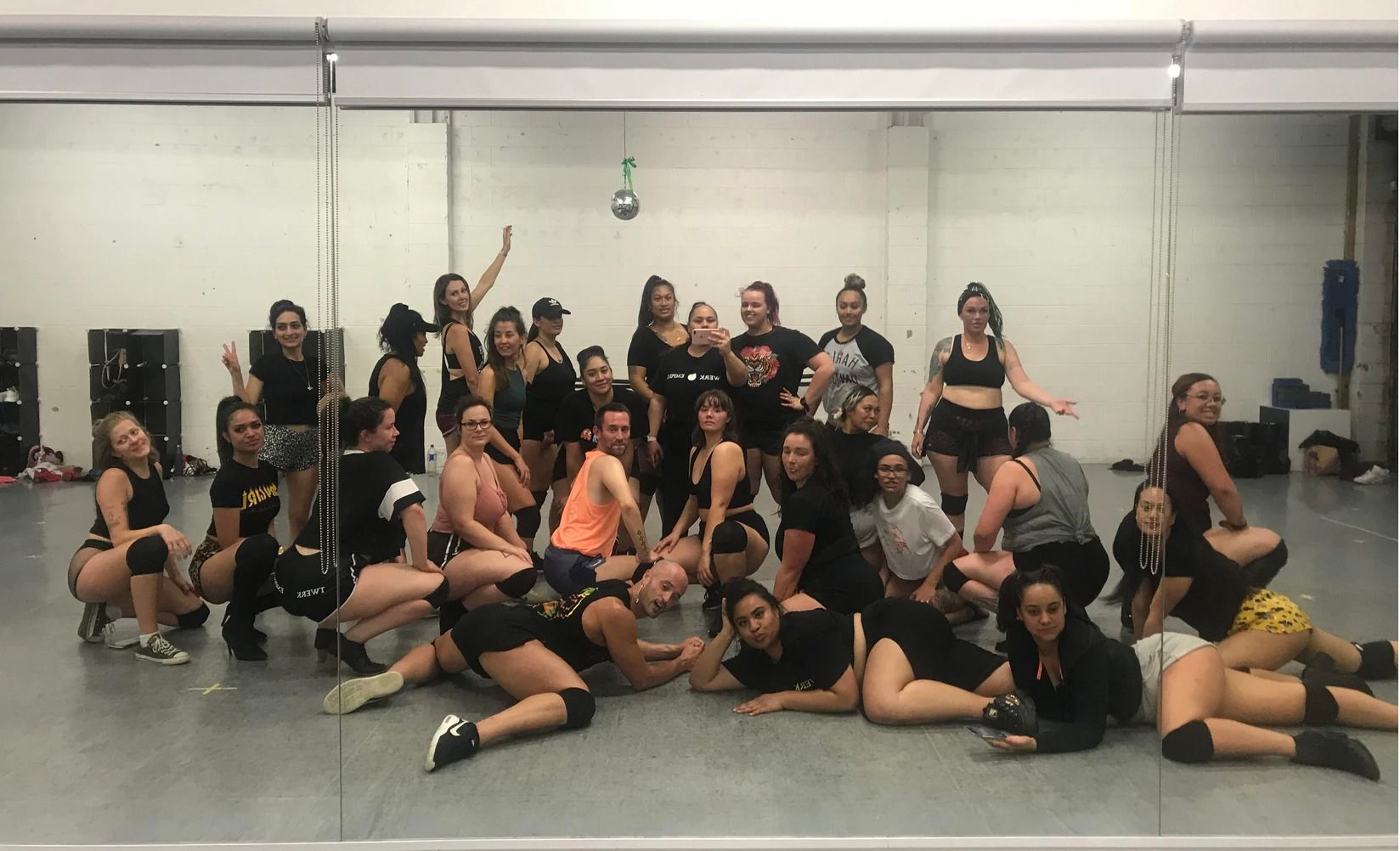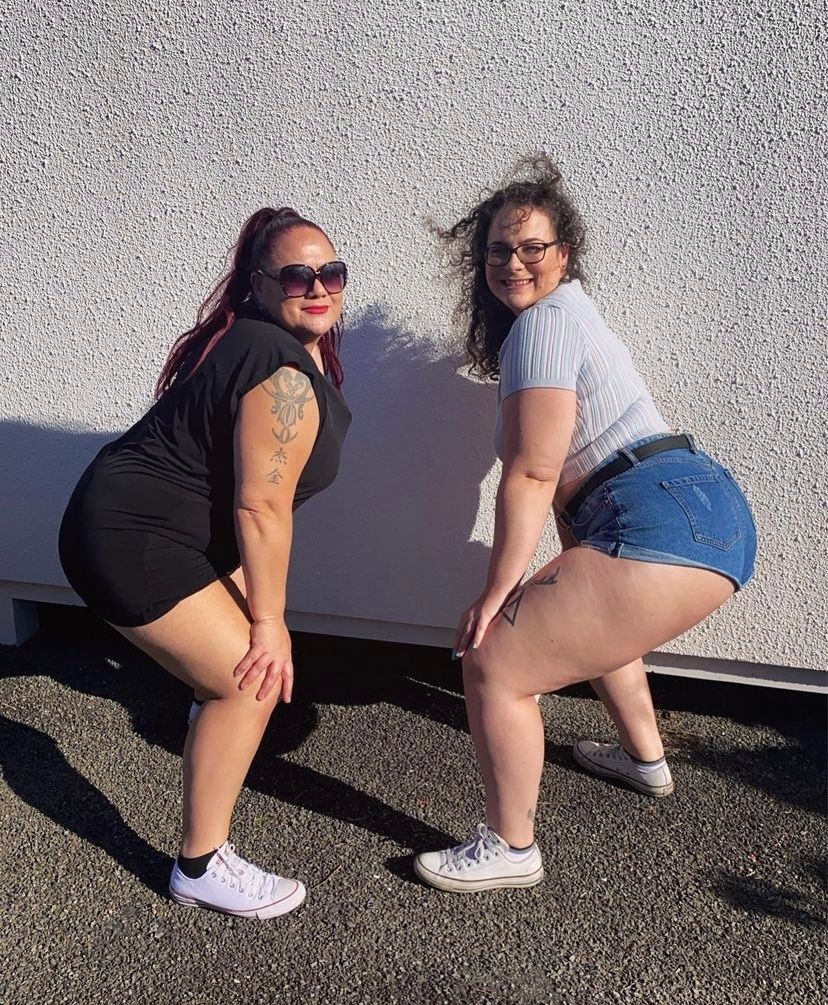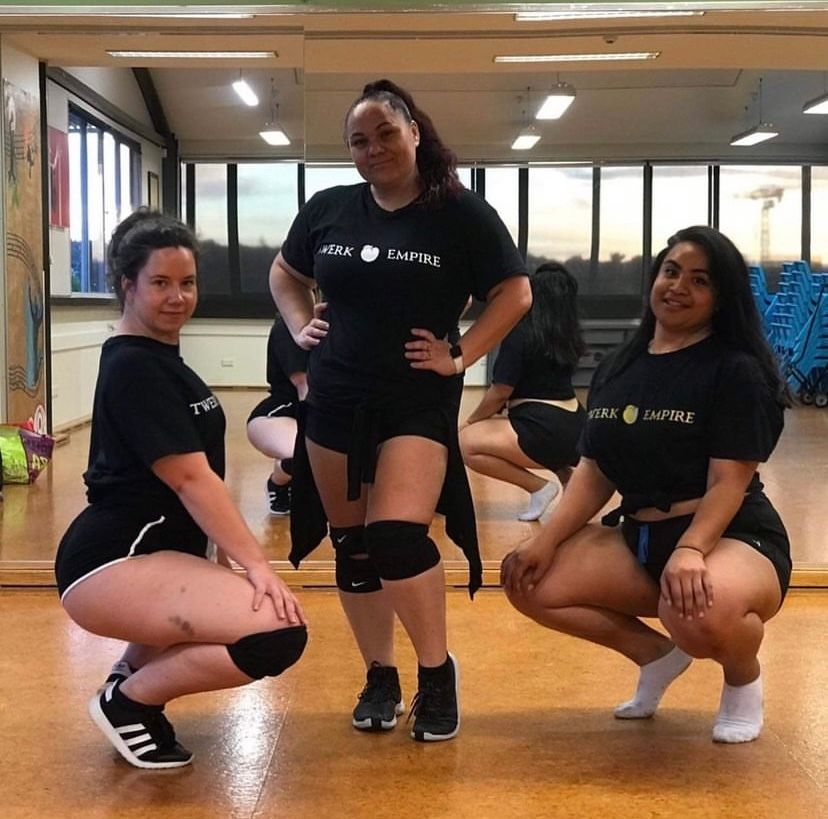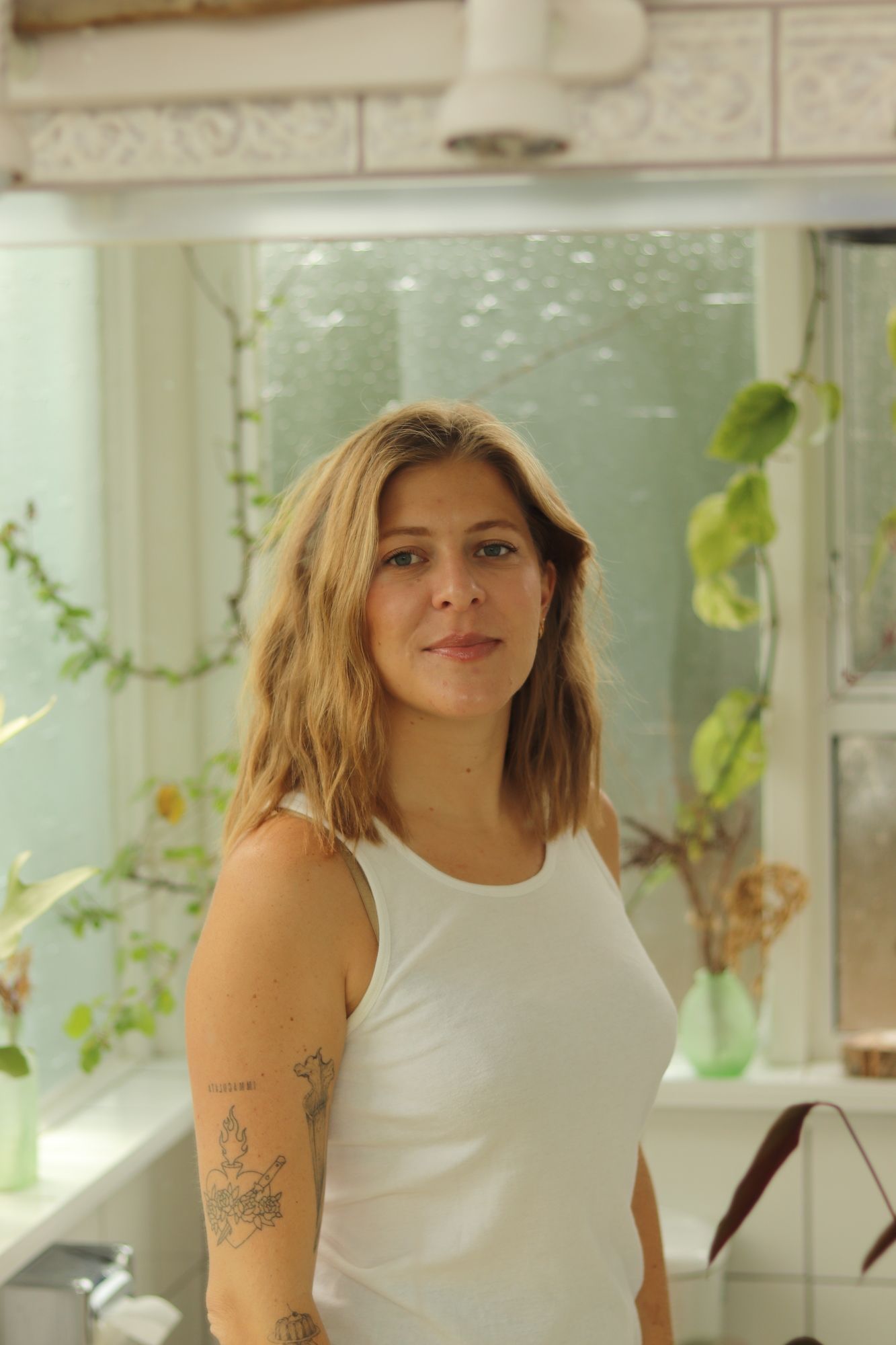Class of Ass
Mary Mosteller chats to Amy Tepania-Ahdo, Tina Fua, and Katie Walker of NZ Twerk Empire about blending the African-American dance form with Moana flavour.
Cosied up in a booth at The Goodhome in Onehunga, we order one of every bar snack and a round of drinks. Our dimpled butt-cheeks are peeping out of tiny twerk shorts, sweaty and sticking to the seat cushions. Tina says a karakia for the food. It’s definitely not the typical post-exercise feed, but NZ Twerk Empire, founded by Amy Tepania-Ahdo, is anything but a typical exercise class.
NZ Twerk Empire runs classes where participants learn to twerk, a dance that originated in African-American communities in which you pop your pelvis up and back. It’s not a dance fitness class– we learn choreography and perform for each other, while hyping each other up.
NZ Twerk Empire, founded by Amy Tepania-Ahdo, is anything but a typical exercise class.
“Oh my god, my knees,” says Katie Walker, massaging her kneecaps. Katie is one of Amy’s OG students. She’s been twerking for almost five years, ever since Amy started teaching. “Tina, you killed us with that choreo tonight.” Tina Fua has just led us in a ‘twerk in heels class’, which featured a Magic Mike-esque slide on our knees, an attempt at the splits, and rolling on the floor ‘sexily’, as Tina likes to say. Tina is a long-time twerker, turned instructor. Amy trained her just last year, and now she runs classes as well as the NZ Twerk Empire Instagram and TikTok.
And then – casually sipping on a lemon, lime and bitters, with her black-cherry hair tied in a tight ponytail – there’s Amy, the one who brings us all together. Tonight, when Tina’s shoes came untied while she was in the middle of a down-dog demo, Amy stopped her so she wouldn’t trip over her laces. She’s our twerk māmā.
Founder Amy Tepania-Ahdo poses with OG student Katie Walker. Image supplied by author.
The Vibe
At the start of the pandemic in 2020, Amy opened NZ Twerk Empire. Previously, she’d been teaching for another twerk business in Tāmaki Makaurau, but over time she realised that her class had taken on its own tikanga, influenced by Amy’s background as wahine Māori. “Without meaning to, we were incorporating Māori values like manaakitanga and whakawhanaungatanga,” says Amy. In branching out on her own, she cultivated inclusivity by establishing a unique method for running class based on her value system.
It’s Amy’s wairua that creates this pluralistic atmosphere, though she would never admit she’s the backbone of it all. In fact, when I asked to interview her she said, “Why don’t you interview Jamie? She has achieved so much, too.” Jamie is another student. Amy explained that every student inspires her, that we all contribute to the vibe of the class. That’s what she loves about twerk – “It’s not about the twerk at all; it’s about the family we’ve built.”
When you walk into the studio, it’s loud. “If I didn’t tell you to stop talking to each other at the start of class, we would never actually twerk,” Amy jokes. At my first class, this energy seemed intimidating. I am very Pākehā. I mean, I trained for 18 years in classical ballet. Sure, I pretend to know how to shake my ass at the club after a few, but trying to make my butt jiggle in a coherent pattern while sober was out of my comfort zone. That was until Amy gave me a hug and kiss on the cheek, and then introduced me to everyone like it was my first day of school and I was a cool girl. Christie, one of the instructors currently on maternity leave, gave me tips on how to ‘flick my fat’. At the end of class, Amy told me I looked like a natural, which couldn’t be less true – I felt like an even more robotic version of Taylor Swift. That night I found out Christie lived down the road from me. The next week I had a carpool buddy, and everyone remembered my name.
Amy treats every student with the same level of familiarity. It’s this hospitality that makes people feel comfortable not only to whip their butt cheeks out, but also to form lasting friendships. There is no power dynamic of student versus instructor. Participants don’t fear speaking up, asking questions, and giving opinions. Amy embodies ako, making everyone feel like trusted equals. “You have to tailor it to who is standing in front of you,” she explains. The intimidation I felt at first was clearly the ghost of exercise classes past; that hierarchy of expertise that uses shame as motivation to burn calories and look better. That rat race: it’s a very Pākehā mentality. It couldn’t be less true in Amy’s dynamic classes, where everyone feels happy in their own skin.
History and Today
“Where do you learn the moves?” I ask. “What do you know about the origins of twerk?” She replies, “Obviously the origins are African, but there were different cultural groups doing it. Everyone was doing different versions of twerk but it wasn’t called twerk back in the day. It’s evolved now.” Tina piggybacks off her statement: “Many different cultures twerk. There’s Jamaica, New Orleans, Brazil. When I first started learning I listened to a lot of podcasts, and watched a lot of videos of people twerking in Trinidad.” One easily accessible resource shared was Lizzo’s Ted Talk “The Black History of Twerking and How It Taught Me Self-Love”. Lizzo outlines how twerk was far-reaching pre-social media. She tells the story of how twerk began as mapouka in West Africa, a dance performed by women in both spiritual and marital ceremonies, then journeyed with these women across the Trans-Atlantic slave trade. From there twerk was crafted and shaped by African American communities– from churches in the South, to New Orleans bounce music in the 80’s, to the Ying Yang Twins 2002 hit “Twurkulator”, to Beyonce twerking in “Crazy in Love'' in 2009. Twerk isn’t just a popular trend, nor was it invented by Miley Cyrus; it has deep roots in Black culture.
Twerk isn’t just a popular trend, nor was it invented by Miley Cyrus; it has deep roots in Black culture.
Of course, twerk has now gone viral. It’s all over TikTok and Instagram. “Pop culture is what made it a thing,” Tina says. Katie agrees, “African American culture and hip hop is really big here. I mean, we see it in all the music videos. I think we’ve done a choreo to every song by Megan Thee Stallion” . In a post-colonial world, twerk does embody this intersection between Indigenous knowledge and popular culture, which is possibly why it is still viewed as controversial by some. White pop culture is so easily accepted – think Britney Spears’ pelvic-thrusting music videos, ardently watched by 90s kids on MTV – but twerking, specifically by Black women, is still judged by many white people, which leads to the over-sexualisation of the movement, instead of seeing it as a practice of celebration and joy.
Katie highlights the obvious: “I’m aware of that, that I am this Pākehā twerking.” Amy agrees: “You have to know the history and respect where it comes from.” By definition, that means respecting who it comes from. Amy honours the African-American roots of twerk the same way she conducts her class: through whakawhanaungatanga. Amy and Tina have built digital connections with well-known twerkers in the States, like Taleah Morris and Destiny Vaughn. Through sharing their work on social media, these African-American women have created an online twerk community where twerkers share their choreo. This allows anyone to try out their moves, with appropriate tagging and crediting. We definitely geeked out the first time Taleah Morris reposted our rendition of her choreo.
Amy keeps it local, too; she says: “It’s relevant in New Zealand – in any country with Indigneous people – we use a lot of hips. The way Cook Islanders move probably matches it the most. There’s that awareness of the pelvis.” She often features musicians like Jess B in her choreo. During Sāmoan language week, she used Sāmoan music and siva-like moves. She has done classes where the students wear lavalava or pāreu instead of shorts. She honours the African history of twerk while blending it with Māori and Pasifika influences.
Image of the class, sourced from the NZ Twerk Empire website. Supplied by author.
Body Empowerment
Besides the friendships, the most important thing NZ Twerk Empire has done for its students is change the way we view our bodies. Katie says she was looking for a new fitness routine when she started twerk, but it turned into so much more. “I am not a natural dancer, but since doing twerk I have gained so much confidence in my body and my mindset. I mean, now I’m posting lingerie photos. I never would have done that five years ago.” She elaborates: “My confidence went through the roof. I am obsessed with myself to the point that I’m conceited now. I don’t need validation from anyone. I still have insecure days, but most of the time I’m like, damn, I look good.”
“As you should!” Tina replies. Tina adds that her own confidence was influenced by watching Katie. “Because we are some of the plus-size ones in class, watching her wear little booty shorts and watching her isolations look so fucking good… because the shorts I was wearing were tight and long.” Amy laughs, and reminds Tina that when she first started twerking, she would also wear a baggy jumper. “That was my comfort zone,” Tina says. “Growing up, I was very body conscious. Being a Pacific Islander, and especially a plus-size Pacific Islander, you are overly sexualised. You’re looked down upon, you don’t get treated the same, and that builds up those feelings. I didn’t want to show my legs. I didn’t wear shorts or crop tops in public, even singlets. But it was the girls at twerk saying ‘you look great in those shorts’ that built up my confidence. I started to love the way my legs looked when they wobbled when I walked. I love my little tummy flopping around. It wasn’t just twerking. It was the friendships, the environment.”
Amy describes the power in representation, in watching people who look like you do something bold. “When you have to stare at yourself in the mirror for an hour you have to face that. There may be someone thicker than you and they’re wearing a sports bra and shorter shorts than you.” “Exactly,” Tina adds, “that energy just bounces off.” “Yeah,” Amy says, “we could change how we look but we don’t want to. Like I don’t wanna go to the gym – fuck that. We can just enjoy the bodies we’re in now.”
"Like I don’t wanna go to the gym – fuck that. We can just enjoy the bodies we’re in now.”
Breaking Stereotypes
As Tina points out, there are many stereotypes about people who twerk. The over-sexualisation of twerk is two sides of the same colonial coin. On one side, it’s seen as immoral (we can thank enduring colonial Christianity for this). This skews society’s perspective of twerkers as improper, and is one of the ways white people continue to dehumanise Black people and BIPOC. On the other side, through the lens of the patriarchy, twerkers are objectified – their only function being to please straight men. This is exemplified in every music video where a grabbed ass is shown without a woman’s face – leaving her practically dismembered.
Like many twerkers, Amy seeks to change these faulty perceptions. She wants to show you that anyone can twerk, for any reason they choose. Just look at the NZ Twerk Empire Instagram and you will see a range of bodies of varying sizes, cultures, backgrounds, and gender identities. Amy breaks down the vibe: “Every person who comes to class is featured on our Insta if they want to be. That’s because people want to see someone and think ‘they look like me.’” Katie elaborates, “Our classes are not for a specific group. We have mums, we have grandmas, we have men.” And she is right; everyone from drag queens to straight men to 60-year-old women come to class. Each person has their own individual motive, but it’s always for themselves, not others. Amy says, “I have never heard of someone who wants to twerk just so they can twerk on their man. Everyone else is gonna have their perceptions about it, but until you’ve experienced the class you won’t know.” Tina adds, “People sexualised it, but we’ve changed the meaning. It’s about us. There is a difference between feeling sexy and being sexualised. You don’t need to validate your sexiness in another person.”
L to R: Instructors Christie McFadyen, Amy Tepania-Ahdo, and Tina Fua. Supplied by author.
Legacy
“Tell me about your most rewarding teaching moment,” I ask. Tina talks about how nerve-wracking it is to come up with choreo, but she says, “Seeing a class love it and do it better than I do, which 90 percent of the class does, that’s what I wanted. It’s when a student says, ‘Thank you so much for helping me overcome my fears.’ That’s my goal. It’s not about making you the best twerker, it’s about making you your best self.” It’s not a surprise that, for Amy, it’s the friendships. “For me, it’s when we are all together outside of twerk, or when I hear you guys are catching up outside of class.” She’s right. If you come to class long enough, you’ll be invited to nights out in town, birthday parties, baby showers or movie nights. She says, “To me, those are the things people remember. Those are the things that save people’s lives or set them on a trajectory towards other amazing things.” Our whanaungatanga is her legacy.
Header image is sourced from the NZ Twerk Empire website, supplied by the author.




